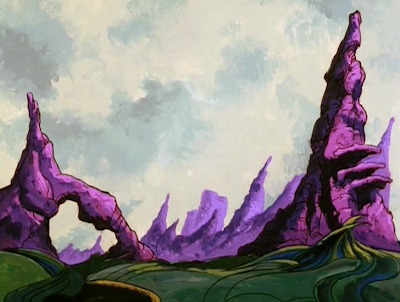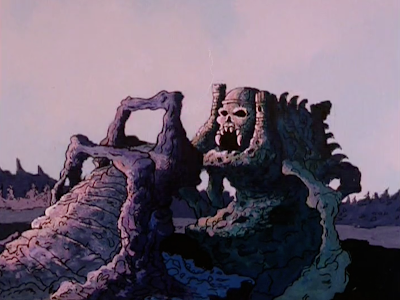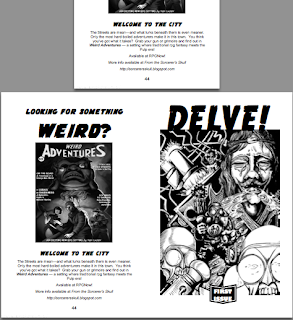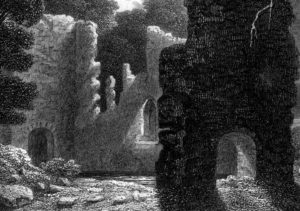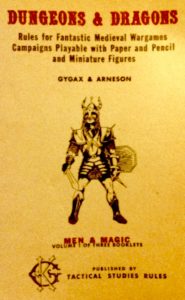TL;DR: Skip to the bottom and roll 3d6 on the table for starting equipment and wealth. Continue reading here if you are interested in the details. You can find PDF versions of these tables on the downloads page.
In OD&D, one is instructed to roll 3d6 * 10 for starting GP and buy all equipment manually. Here is a one-roll method which uses a 3d6 table. This table has 64 different starting packages, one for each class at each potential starting wealth level. I built it strictly using the prices and equipment in Men & Magic, so should be useful in any vanilla OD&D game. Buying equipment has traditionally been the most time consuming part of creating a D&D character, but hopefully this can speed the process up. Maybe I should have broken this post into several more specific posts, but most of the following sections have bearing on starting equipment, so I have left it all together.
The OD&D equipment list can be broken into the following categories (GP prices are in parentheses):
- One-handed melee weapons: dagger (3), hand axe (3), mace (5), sword (10), battle axe (7), morning star (6), flail (8)
- Two-handed melee weapons: spear (1), pole arm (7), halberd (7), two-handed sword (15), lance (4), pike (5)
- Missile weapons: short bow (25), long bow (40), composite bow (50), light crossbow (15), heavy crossbow (25), quiver 20 arrows (10), case 30 quarrels (10), 20 arrows/30 quarrels (5)
- Animals & accessories: mule (20), draft horse (30), light horse (40), medium warhorse (100), heavy warhorse (200), saddle (25), saddle bags (10), barding (150)
- Armor: leather (15), chain (30), plate (50), helmet (10), shield (10)
- Exploration gear: rope (1), 10′ pole (1), iron spikes (1)
- Containers: small sack (1), large sack (2), backpack (5), water/wine skin (1)
- Light sources: 6 torches (1), lantern (10), flask of oil (2)
- Bug spray: 3 stakes & mallet (3), steel mirror (5), silver mirror (15), wooden cross (2), silver cross (25), vial of holy water (25), wolvesbane (10), belladona (10), garlic (5)
- Rations: quart of wine (1), week iron rations (15), week standard rations (5)
STARTING WITH SCROLLS
I have given all magic-users that roll 11 or more for starting wealth a scroll. First level scrolls for 100 GP are present in the rules (Men & Magic page 7), though they can’t be created by magic-users prior to 11th (“wizard”) level. Because of this, one won’t actually find scrolls for sale at the price of 100 GP in the game world, but it seems like a reasonable cost for assessing starting equipment. Determine the particular spell in any way desired. Rolling 1d8 on the table of first level spells (page 21) seems eminently reasonable to me. Another option would be to let the player pick one of the spells that they can cast under the assumption that they scribed the scroll before play started. For added spice you may want to roll for the level as well; there are few things more entertaining than giving a first level magic-user one use of disintegrate, animate dead, or fireball.
CLERIC WEAPONS
If I were to interpret weapons allowed for clerics conservatively and stick to the weapons listed explicitly in Men & Magic, the poor cleric would be left with only one weapon: the mace (and even some flanged maces are arguably edged, but I won’t go there). However, the book does helpfully add: “Other items cost may be calculated by comparing to similar items listed above” (Men & Magic page 14). I think the most appropriate list of starting weapons is probably what Cameron DuBeers suggested:
Mace, hammer, club, quarter-staff.
I’ve gone several ways with slings. I eventually settled on disallowing them, reasoning that a cleric or anti-cleric would want to punish the enemies of his faith by his own hand.
Derived prices are 5 GP for a war hammer (based on the price of a mace) and 1 GP for either a club, cudgel, or quarter-staff. Thank you also to everyone else who responded to the topic about cleric weapons over at ODD74.
CLERIC SCROLLS
According to the rules, “There is a 25% chance that any scroll of spells found will contain those usable by clerics” (Monsters & Treasure page 24). But also: “All Scrolls are spells for Magic-Users, and regardless of the level of the spell they can be used by any Magic-User capable of reading them” (Monsters & Treasure page 32). In addition, nowhere in the rules does it state that clerics can create magic items of any kind, though Men & Magic dedicates half a page to wizardly creation of magic items. How do we reconcile these seeming contradictions without assuming an editorial mistake? Here is one way (the quote is from ralph on ODD74):
Scrolls will contain those spells usable by clerics 25% of the time, but are for Magic Users.
How many spells appear on both classes lists? (I don’t have my books available at the moment.)
Could it be those spells that are on 25% of scrolls?
In other words, clerics can cast spells from “magic-user” scrolls, but only those spells that show up on the cleric spell list. Here is a list of those overlapping spells, sorted by cleric level.
- Light (C 1, MU 1)
- Detect Magic (C 1, MU 1)
- Protection from Evil (C 1, MU 1)
- Detect Evil (C 1, MU 2)
- Hold Person (C 2, MU 3)
- Locate Object (C 3, MU 2)
- Continual Light (C 3, MU 2)
- Remove Curse (C 3, MU 4)
- Protection from Evil, 10′ radius (C 4, MU 3)
One could roll d4 on this table to select the contents of a beginning cleric scroll.
BUNDLES FOR RE-EQUIPPING
- Budget explorer (22 GP): backpack, waterskin, 6 torches, 1 week iron rations
- Deluxe explorer (39 GP): backpack, waterskin, lantern, 4 flasks oil, 1 week iron rations
- Budget vampire slayer (10 GP): 3 stakes & mallet, steel mirror, wooden cross
- Deluxe vampire slayer (73): 3 stakes & mallet, silver mirror, silver cross, vial of holy water, garlic
- Werewolf slayer (35): 5 silver tipped arrows, wolvesbane
- Heavy infantry (83): plate armor, shield, helmet, sword, dagger
- Budget infantry (19): leather armor, spear, dagger
- Archer (78): leather armor, longbow, quiver of 20 arrows, sword, dagger
- Skulk (24): leather armor, dagger, 50′ rope, belladona
- Spelunker (6): 50′ rope, 10′ pole, 12 iron spikes, 3 stakes & mallet
RATIONS
There are two types of rations: iron (15 GP for one week) and standard (5 GP for one week). Iron rations are explicitly described as “for dungeon expeditions” (Men & Magic page 14). Given that most low-level adventurers will be crawling dungeons (as the wilderness is too dangerous), it seems important that all starting packages include some iron rations (even though that is half of starting wealth on the low end of the roll).
I am going with the interpretation that standard rations are still relatively resistant to spoilage, but often require cooking. This is one reason why they are not going to be as useful for dungeon exploration, unless you also bring firewood and kindling (good luck keeping it dry). Also, consider that cooking in a dungeon, even if possible, will likely attract attention. So the quick take-away here is that iron rations are for the underworld and standard rations are for the wilderness.
Also remember that rations have a secondary purpose in OD&D: as a distraction for pursuing monsters. From The Underworld & Wilderness Adventure, page 12:
Edible items will have a small likelihood (10%) of distracting intelligent monsters from pursuit. Semi-intelligent monsters will be distracted 50% of the time. Non-intelligent monsters will be distracted 90% of the time by food.
Treasure will have the opposite reaction as food, being more likely to stop intelligent monsters.
In that light, standard rations may be considered more edible by monsters than iron rations. I would probably only use the above distraction probabilities for standard rations, so you might also want to stock up on standard rations to use as monster bait. However, standard rations will quickly become inedible to mortals in the strange environment of the underworld. (Side note: mentioned just prior to the above quote on the same page, burning oil is also a good deterrent.)
See this thread and this thread for more discussion.
PAHVELORN-SPECIFIC NOTES
With the exception of mounts (horses are rare and valuable), all the prices in Men & Magic are valid for the town of Zorfath. Note that clerics in my campaign can use any weapon, but I have kept the table to non-edged weapons as per the rules so that this can be useful to others as well. If you are playing in my campaign, feel free to drop down one category and add a sword, or take the fighter entry rather than the cleric entry. In fact, if you want to play against type (for example, a diabolist magic-user disguised as a soldier), feel free to take the starting package for any class at the level rolled.
TABLE FOR STARTING EQUIPMENT
| 3d6 | Cleric | Fighter | Magic-User | Thief |
|---|---|---|---|---|
| 3 | cudgel, 6 torches, backpack, waterskin, 1 week iron rations, 10′ pole, wooden cross, 4 GP | spear, dagger, 6 torches, backpack, waterskin, 1 week iron rations, 50′ rope, 3 GP | dagger, 6 torches, backpack, waterskin, 1 week iron rations, 10′ pole, 4 GP | cudgel, sling, pouch with 20 sling bullets, 6 torches, backpack, waterskin, 1 week iron rations, 50′ rope, 4 GP |
| 4 | cudgel, shield, 6 torches, backpack, waterskin, 1 week iron rations, 50′ rope, wooden cross, 4 GP | cudgel, leather armor, 6 torches, backpack, waterskin, 1 week iron rations, 10′ pole, 1 GP | 2 daggers, 6 torches, backpack, waterskin, 1 week iron rations, 2 flasks oil, 50′ rope, 7 GP | cudgel, leather armor, 6 torches, backpack, waterskin, 1 week iron rations, 10′ pole, 1 GP |
| 5 | mace, leather armor, 6 torches, backpack, waterskin, 1 week iron rations, 10′ pole, wooden cross, 5 GP | leather armor, morning star, dagger, 6 torches, backpack, waterskin, 1 week iron rations, 50′ rope, 3 GP | dagger, backpack, waterskin, lantern, 4 flasks oil, 1 week iron rations, 10′ pole, 7 GP | cudgel, dagger, sling, pouch with 20 sling bullets, leather armor, 6 torches, backpack, waterskin, 1 week iron rations, 50′ rope, 6 GP |
| 6 | quarter-staff, leather armor, 6 torches, backpack, waterskin, 1 week iron rations, 50′ rope, 12 iron spikes, wooden cross, 3 stakes & mallet, steel mirror, 10 GP | leather armor, battle axe, hand axe, dagger, sling, pouch with 20 sling bullets, 6 torches, backpack, waterskin, 1 week iron rations, 10′ pole, 7 GP | dagger, 6 torches, backpack, waterskin, 1 week iron rations, 50′ rope, vial of holy water, 9 GP | sword, dagger, leather armor, 6 torches, backpack, waterskin, 1 week iron rations, 10′ pole, 9 GP |
| 7 | chain armor, war hammer, 6 torches, backpack, waterskin, 1 week iron rations, 10′ pole, wooden cross, 2 small sacks, 8 GP | chain armor, spear, dagger, sling, pouch with 20 sling bullets, 6 torches, backpack, waterskin, 1 week iron rations, 50′ rope, 11 GP | dagger, 6 torches, backpack, waterskin, 1 week iron rations, 10′ pole 5 flasks of oil, silver mirror, belladona, 9 GP | cudgel, light crossbow, case with 30 quarrels, leather armor, 6 torches, backpack, waterskin, 1 week iron rations, 50′ rope, 6 GP |
| 8 | chain armor, shield, mace, 6 torches, backpack, waterskin, 1 week iron rations, 50′ rope, wooden cross, 2 small sacks, 8 GP | chain armor, shield, sword, dagger, 6 torches, backpack, waterskin, 1 week iron rations, 10′ pole, 4 GP | dagger, 6 torches, backpack, waterskin, 1 week iron rations, 50′ rope, 2 vials holy water, 4 GP | sword, light crossbow, case of 30 quarrels, leather armor, 6 torches, backpack, waterskin, 1 week iron rations, 10′ pole, 7 GP |
| 9 | chain armor, shield, war hammer, 6 torches, backpack, waterskin, 1 week iron rations, 10′ pole, wooden cross, 2 small sacks, 3 stakes & mallet, steel mirror, 10 GP | chain armor, spear, light crossbow, case with 30 quarrels, 6 torches, backpack, waterskin, 1 week iron rations, 50′ rope, 11 GP | 3 daggers, backpack, waterskin, lantern, 4 flasks oil, 1 week iron rations, 10′ pole, vial of holy water, 16 GP | sword, 2 daggers, 35 short bow, quiver of 20 arrows, leather armor, 6 torches, backpack, waterskin, 1 week iron rations, 50′ rope, 1 GP |
| 10 | plate armor, shield, mace, 6 torches, backpack, waterskin, 1 week iron rations, 50′ rope, wooden cross, 10 GP | plate armor, shield, sword, dagger, 6 torches, backpack, waterskin, 1 week iron rations, 10′ pole, 4 GP | dagger, 6 torches, backpack, waterskin, 1 week iron rations, 50′ rope, 2 vials holy water, 24 GP | sword, dagger, leather armor, backpack, waterskin, lantern, 4 flasks oil, 1 week iron rations, 10′ pole, 32 GP |
| 11 | plate armor, shield, war hammer, backpack, waterskin, lantern, 4 flasks oil, 1 week iron rations, 10′ pole, wooden cross, small sack, 2 GP | plate armor, two-handed sword, 3 daggers, 6 torches, backpack, waterskin, 1 week iron rations, 50′ rope, 2 flasks oil, 9 GP | dagger, backpack, waterskin, lantern, 4 flasks oil, 1 week iron rations, 10′ pole, 67 GP | sword, light crossbow, case of 30 quarrels, 2 silver tipped quarrels, leather armor, backpack, waterskin, lantern, 4 flasks oil, 1 week iron rations, 50′ rope, 10 GP |
| 12 | plate armor, quarter-staff, backpack, waterskin, lantern, 4 flasks oil, 1 week iron rations, 50′ rope, silver cross, 4 GP | plate armor, shield, sword, light crossbow, case with 30 quarrels, 6 torches, backpack, waterskin, 1 week iron rations, 10′ pole, 2 GP | dagger, backpack, waterskin, lantern, 4 flasks oil, 1 week iron rations, 50′ rope, 77 GP | sword, dagger, short bow, quiver of 20 arrows, leather armor, backpack, waterskin, lantern, 4 flasks oil, 1 week iron rations, 10′ pole, 17 GP |
| 13 | cudgel, 6 torches, backpack, waterskin, 1 week iron rations, 10′ pole, wooden cross, scroll, 4 GP | plate armor, flail, dagger, 35 short bow, quiver of 20 arrows, 6 torches, backpack, waterskin, 1 week iron rations, 50′ rope, small sack, 10 GP | dagger, 6 torches, backpack, waterskin, 1 week iron rations, scroll, 10′ pole, 4 GP | sword, leather armor, backpack, waterskin, lantern, 4 flasks oil, 1 week iron rations, 50′ rope, 65 GP |
| 14 | plate armor, shield, mace, backpack, waterskin, lantern, 4 flasks oil, 1 week iron rations, 50′ rope, silver cross, 10 GP | plate armor, shield, sword, light crossbow, case with 30 quarrels, backpack, waterskin, lantern, 4 flasks oil, 1 week iron rations, 10′ pole, 5 GP | 2 daggers, 6 torches, backpack, waterskin, 1 week iron rations, scroll, 50′ rope, 11 GP | sword, light crossbow, case of 30 quarrels, 6 silver tipped quarrels, leather armor, backpack, waterskin, lantern, 4 flasks oil, 1 week iron rations, 10′ pole, 20 GP |
| 15 | leather armor, mace, 6 torches, backpack, waterskin, 1 week iron rations, 10′ pole, wooden cross, scroll, 2 flasks oil, 1 GP | plate armor, helmet, 2 battle axes, dagger, light crossbow, case with 30 quarrels, 6 torches, backpack, waterskin, 1 week iron rations, 50′ rope, 5 flasks oil, 15 GP | dagger, backpack, waterskin, lantern, 4 flasks oil, 1 week iron rations, scroll, 10′ pole, 7 GP | sword, short bow, quiver of 20 arrows, 6 silver tipped arrows, leather armor, backpack, waterskin, lantern, 4 flasks oil, 1 week iron rations, 50′ rope, 20 GP |
| 16 | plate armor, shield, helmet, war hammer, backpack, waterskin, lantern, 4 flasks oil, 1 week iron rations, 50′ rope, silver cross, 3 stakes & mallet, steel mirror, 12 GP | plate armor, two-handed sword, dagger, short bow, quiver of 20 arrows, backpack, waterskin, lantern, 4 flasks oil, 1 week iron rations, 10′ pole, 2 small sacks, 15 GP | dagger, backpack, waterskin, lantern, 4 flasks oil, 1 week iron rations, scroll, 50′ rope, 17 GP | sword, 4 daggers, leather armor, backpack, waterskin, lantern, 4 flasks oil, 1 week iron rations, 10′ pole, 98 GP |
| 17 | chain armor, war hammer, 6 torches, backpack, waterskin, 1 week iron rations, 10′ pole, wooden cross, scroll, 10 GP | plate armor, halberd, dagger, long bow, quiver of 20 arrows, 2 silver tipped arrows, backpack, waterskin, lantern, 4 flasks oil, 1 week iron rations, 50′ rope, 10 GP | dagger, backpack, waterskin, lantern, 4 flasks oil, 1 week iron rations, scroll, 10′ pole, 27 GP | sword, light crossbow, case of 30 quarrels, leather armor, backpack, waterskin, lantern, 4 flasks oil, 1 week iron rations, 50′ rope, 80 GP |
| 18 | plate armor, shield, helmet, mace, backpack, waterskin, lantern, 4 flasks oil, 1 week iron rations, 50′ rope, silver cross, vial holy water, 12 iron spikes, 3 stakes & mallet, small sack, 10 GP | plate armor, shield, helmet, sword, 2 daggers, light crossbow, case with 30 quarrels, 4 silver tipped quarrels, backpack, waterskin, lantern, 4 flasks oil, 1 week iron rations, 10′ pole, 9 GP | dagger, backpack, waterskin, lantern, 4 flasks oil, 1 week iron rations, scroll, 50′ rope, 37 GP | sword, 3 daggers, short bow, quiver of 20 arrows, 8 silver tipped arrows, leather armor, backpack, waterskin, lantern, 4 flasks oil, 1 week iron rations, 10′ pole, 31 GP |












